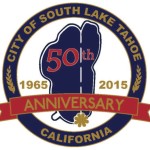Early years of S. Lake Tahoe come to life

Laurel Ames, Betty Mitchell and John Cefalu talk June 10 about the early days of South Lake Tahoe. Photo/Kathryn Reed
By Kathryn Reed
Nuggets of South Lake Tahoe’s 50-year history were uncovered Wednesday night as three longtime locals bantered about days gone by.
Laurel Ames, Betty Mitchell and John Cefalu spoke about the early days of the city and how some things are better, and some not so much. They weren’t the only ones who remembered what it was like. About a dozen people in the audience raised their hands when asked who was around when the incorporation took place.
Ames and Mitchell were two of the powerhouses behind the two-year process that led to the eventu al incorporation of the city in November 1965. They said it was a group effort to pull it off – with many of the 14,000 people living here at the time volunteering to do whatever was needed.
al incorporation of the city in November 1965. They said it was a group effort to pull it off – with many of the 14,000 people living here at the time volunteering to do whatever was needed.
These were the days before computers, the ability to mail merge, and adhesive stamps. Addressing parties were necessary to get information to people. It meant addressing envelopes by hand, licking stamps, licking envelopes. At that time so many people were not registered to vote because they feared getting called for jury duty, which would have meant driving to the courthouse in Placerville.
One of the first issues to be dealt with was what area should the city occupy. There was no money for a survey, so the South Tahoe Public Utility District boundaries were used. The only time this was expanded was when the city took over the operation of Lake Tahoe Airport from El Dorado County.
“Heavenly Valley was pure politics. (Owner Hugh) Killebrew came to us and said, ‘If you keep me in the boundary, I’ll sue you’,” Ames recalled. That is why the California Base Lodge is in the county. Incorporation proponents didn’t have the means to fight a legal battle.
Cefalu remembers being at the old high school for the Caltrans meeting to discuss the agency’s proposed freeway through town.
“The fact that the freeway was to have an off-ramp into Harrah’s parking lot aggravated Harvey Gross, (owner of Harveys casino),” Cefalu said.
He said if the freeway had been built, it would have been a disaster for the community.
Folks in Placerville didn’t want much to do with those in the Lake Tahoe Basin, other than to collect the tax revenue, while returning little of it.
Mitchell recalled the time she and her husband were going to put an addition on their house. They tried to get a permit, even wanted to pay for it.
“They said you don’t need it; that no one would come to inspect it,” Mitchell said.
This, though, led to a lot of the funkiness of the city and poor craftsmanship in some cases.
Ames misses the big trees that used to line Highway 50, adding this is one of the sadder changes.
Signs were an early bugaboo for officials. That is one ordinance that remains contentious today, primarily because of the lack of enforcement.
Harrison Avenue came about after parking was eliminated along Highway 50. Frank Globin, according to Cefalu, created a 1-foot easement on the Caltrans side so there would always be a buffer. This property came into play during the recent Harrison Avenue upgrades.
Cefalu said for years the city endured the wrath of the state transportation department because the electeds voted against the freeway and the citizenry said the same.
The good ol’ boy network was established before incorporation became a reality. There was a group called the Roosters.
“Five of those folks were elected to the City Council so you can see where the influence started,” Cefalu said.